Our Low FODMAP Cornmeal Berry Snack Cake is like a slightly sweet cornbread – half bread, half cake – buttery, soft and studded with raspberries and blueberries. And it can be whipped up in the time it takes the oven to preheat.
Let’s Talk Cornmeal
Corn, in many guises, can be enjoyed while on the low FODMAP diet. In this Low FODMAP Cornmeal Berry Snack Cake recipe we take advantage of medium or finely ground cornmeal.
The Monash app lists several ground corn products, which we will address in a moment. FODMAP Friendly has lab tested what they label as maize or cornflour, with the image depicting the kind of finely ground cornmeal that we use in this recipe, and they give it a “Pass” at ¾ cup or 100 g.
Here are the products that Monash has lab tested and listed. Note that the spellings are theirs and not necessarily the way we would represent the products:
- Flour, corn (corn starch) – Low FODMAP at 2/3 cup 100 g.
- Flour, corn (masa harina/masa lista) – Low FODMAP at 2/3 cup 100 g.
- Polenta (cornmeal) – Low FODMAP at 1 cup cooked 255g.
- Starch, maize – Low FODMAP at 2/3 cup 100 g (this is what we call cornstarch in the U.S.)
Monash has also listed generous low FODMAP servings of other corn products such as corn tortillas, corn chips, corn flake style cereal and other products.
Masa Harina vs. Regular Cornmeal
In addition, we had in-person conversation with Dr. Peter Gibson and Dr. Emma Halmos specifically about the “masa harina” listing in the app. At the time (Fall 2019), the app called the entry “Flour, corn”. I was about to work on a Tamales recipe and asked them about masa harina, which is cornmeal treated with lime. Long story short, what they had tested was masa harina and due to our convo the listing was updated. But what did that mean about “regular” cornmeal not treated with lime, which was not otherwise represented on the app? How would this apply to this Low FODMAP Cornmeal Berry Snack Cake?
The other “Flour, corn” listing specified “(corn starch)” was not what we were interested in. What we call “cornstarch” in the U.S. is what this listing is referring to. As you probably know, we use cornstarch as a thickener, such as for pudding. We do not use “cornstarch” for cornbread or dishes such as this Low FODMAP Cornmeal Berry Snack Cake.
They assured us that the additive of lime would not make a difference from a FODMAP perspective. Therefore, the extrapolation is that “regular” cornmeal is similar, if not the same, from a FODMAP perspective as the masa harina. This would also align with the results that were reported by FODMAP Friendly.
Cornmeal: Fine, Medium & Coarse
In the U.S. cornmeal comes in many levels of fineness/coarseness. One type does not necessarily work in a recipe where another is required. The most obvious and extreme example I can give you is a recipe for grits or polenta, both which call for coarser grinds of cornmeal. You cannot make these with a finely ground cornmeal.
Hopefully a recipe will tell you exactly what is needed. If it does not, then the assumption would be a fine or medium grind cornmeal and you can often get away with substituting one of these for the other. This Low FODMAP Cornmeal Berry Snack Cake works fine with either.
I like to buy cornmeal in bulk, if I can, because then I can just buy what I need, ensuring that I always have a fresh product. If you buy a package that contains more than you need, I suggest placing everything in a heavy freezer-safe zip top bag or freezer-worthy airtight container and store it there until needed (or up to 6 months).
If you think you will be using it up within a month, store in the fridge, if you have room.
Blackberries vs. Blueberries & Raspberries
This recipe is based upon one that used blackberries in Alison Roman’s book, Nothing Fancy: Unfussy Food for Having People Over. It calls for a whopping 2 pints of blackberries.
About Blackberries & FODMAPs
Here’s the deal with blackberries. Blackberries have been lab tested by both Monash University and FODMAP Friendly. The Monash lab results state that 1 small berry at 4g is Green Light low FODMAP. FODMAP Friendly has lab tested blackberries and gives them a “Pass” at 1 cup (150 g).
What are we to make of this? Well, first of all, different labs can result in different results. Also, a batch of blackberries from farm A harvested on a particular day will very likely be different from batch of blackberries from farm B harvested on a a different day. Different ripeness level, soil, variety, etc.
I might choose to use blackberries as the focus in a different recipe, but for this one I chose to go with a mixture of blueberries and raspberries.
About Raspberries & FODMAPs
Raspberries have also been lab tested by both Monash University and FODMAP Friendly. FODMAP Friendly gives them a “Pass” at 10 berries or 45 g. Monash states that a Green Light low FODMAP serving is 30 berries or 60 g. In their tests the fruit jumped to Moderate FODMAP levels quickly at 35 berries or 65 g. What to make of this? See above and below.
About Blueberries & FODMAPs
Blueberries have also been lab tested by both Monash University and FODMAP Friendly. FODMAP Friendly gives them a “Pass” at 1 cup or 150 g. Monash states that a Green Light low FODMAP serving is a heaping ¼ cup or 40 g. In their tests the fruit jumped to Moderate FODMAP levels quickly at ⅓ cup or 50 g. What to make of this? See our blackberry discussion above.
Also, what really matters is how YOU digest a particular item. Please review our article, What Is A Low FODMAP Serving Size.
Our recommended serving size of this cake will keep you within low FODMAP lab tested limits.
How To Make Low FODMAP Cornmeal Berry Snack Cake
This is a very easy to make cake. Great for beginner cooks and bakers alike.
You start by making a faux “buttermilk”, which is simply a soured milk. You can read more about it in our article on making lactose-free buttermilk.
The berries are mashed with a bit of sugar, which helps their juices exude – and you will be including those juices in the cake!
Dry ingredients are whisked together to aerate and combine.
Melted butter adds richness, while a little vegetable oil adds softness to the crumb.
It really is a matter of just combining wet ingredients and dry. No electric mixer needed.
If you want to be ready to make recipes quickly and easily – be prepared! Check out our article on 12 Essential Pantry Items, 10 Essential Low FODMAP Baking Items and 8 Essential Fridge & Freezer Items.
Let’s Make Low FODMAP Cornmeal Berry Snack Cake!
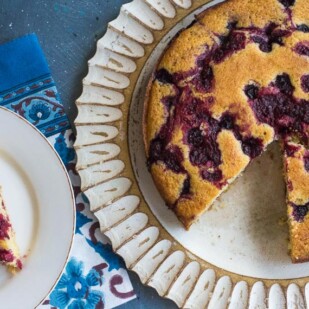
Low FODMAP Cornmeal Berry Snack Cake
Our Low FODMAP Cornmeal Berry Snack Cake is like a slightly sweet cornbread – half bread, half cake – buttery, soft and studded with raspberries and blueberries. And it can be whipped up in the time it takes the oven to preheat.
Ingredients:
- ½ cup (120 ml) lactose-free whole milk, at room temperature
- 2 teaspoons lemon juice
- ½ cup (63 g) plus 2 tablespoons fresh blueberries
- ½ cup (68 g) plus 2 tablespoons fresh raspberries
- 2/3 cup (131 g) plus 2 tablespoons sugar, divided
- 1 cup (145 g) low FODMAP, gluten-free all-purpose flour, such as Bob’s Red Mill Gluten Free 1 to 1 Baking Flour
- 3/4 cup (104 g) medium-grind yellow cornmeal (finely ground can be used)
- 2 teaspoons baking powder; use gluten-free if following a gluten-free diet
- ½ teaspoon salt
- 1/2 cup (113 g; 1 stick) unsalted butter, melted
- 1/4 cup (60 ml) neutral flavored vegetable oil, such as canola, rice bran or blended vegetable oil
- 2 large eggs at room temperature
Preparation:
-
Position rack in middle of oven. Preheat the oven 350°F (180°C). Coat the inside of a 9-inch (23 cm) springform pan with nonstick spray; set aside.
-
Combine milk and lemon juice and set aside for 5 minutes to thicken in a large bowl. Meanwhile, place all of the berries in a non-reactive bowl, sprinkle with 2 tablespoons of sugar, then use a potato masher to lightly crush the berries. Set aside and juices will begin to exude, which you want.
-
In a separate bowl, whisk together the flour, cornmeal, baking powder and salt to aerate and combine. Set aside.
-
Going back to the thickened, soured milk, whisk in the melted butter and oil, then whisk in the remaining 2/3 cup (131 g) sugar and the eggs until everything is well combined and smooth. Whisk in dry ingredients until a few floury streaks remain, then add about three-quarters of the berries and any juices (you can do this by eye), switch to a silicone spatula and fold all the ingredients together well.
-
Scrape the batter into the prepared pan and top with the remaining berries and their juices.
-
Bake for about 35 to 40 minutes until cake is golden brown and a toothpick inserted in the center comes out clean. Cool on rack for 5 minutes, then unmold from pan. Cake may be eaten warm or cool to room temp. It is best enjoyed the day it is made but leftovers can be wrapped in foil and kept at room temperature for a day or two.
Notes:
Tips
FODMAP Information
Our recipes are based on Monash University and FODMAP Friendly science.
- Blueberries: Blueberries have also been lab tested by both Monash University and FODMAP Friendly. FODMAP Friendly gives them a “Pass” at 1 cup or 150 g. Monash states that a Green Light low FODMAP serving is a heaping ¼ cup or 40 g. In their tests the fruit jumped to Moderate FODMAP levels quickly at ⅓ cup or 50 g.
- Eggs: Eggs are high in protein and do not contain carbohydrates, according to Monash University.
- Raspberries: Raspberries have been lab tested by both Monash University and FODMAP Friendly. FODMAP Friendly gives them a “Pass” at 10 berries or 45 g. Monash states that a Green Light low FODMAP serving is 30 berries or 60 g. In their tests the fruit jumped to Moderate FODMAP levels quickly at 35 berries or 65 g.
- Sugar: Monash University and FODMAP Friendly have both lab tested white, granulated sugar. Monash states that a Green Light low FODMAP serving size of white sugar is ¼ cup (50 g). FODMAP Friendly simply states that they have tested 1 tablespoon and that it is low FODMAP. Regular granulated white sugar is sucrose, which is a disaccharide made up of equal parts glucose and fructose. Sucrose is broken down and absorbed efficiently in the small intestine.
Please always refer to the Monash University & FODMAP Friendly smartphone apps for the most up-to-date lab tested information. As always, your tolerance is what counts; please eat accordingly. The ultimate goal of the low FODMAP diet is to eat as broadly as possible, without triggering symptoms, for the healthiest microbiome.
Nutrition
All nutritional information is based on third-party calculations and should be considered estimates. Actual nutritional content will vary with brands used, measuring methods, portion sizes and more. For a more detailed explanation, please read our article Understanding The Nutrition Panel Within Our Recipes.
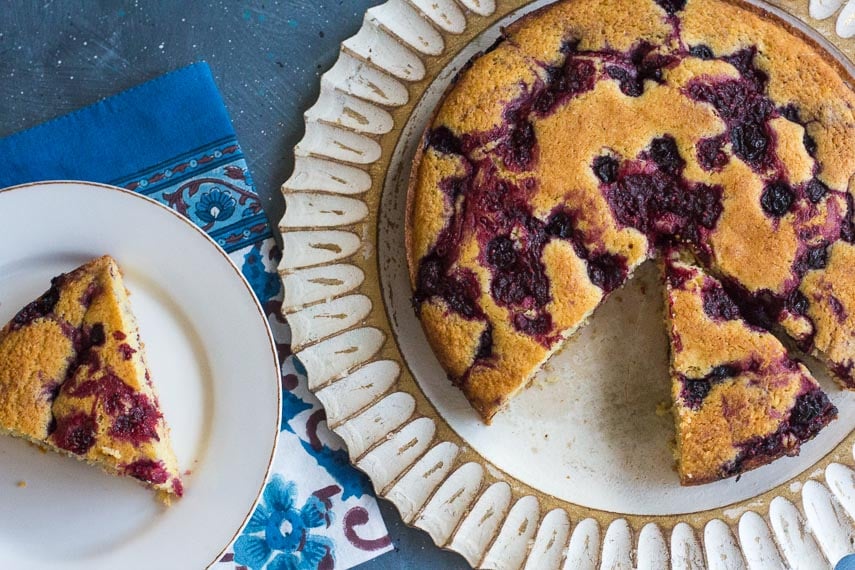
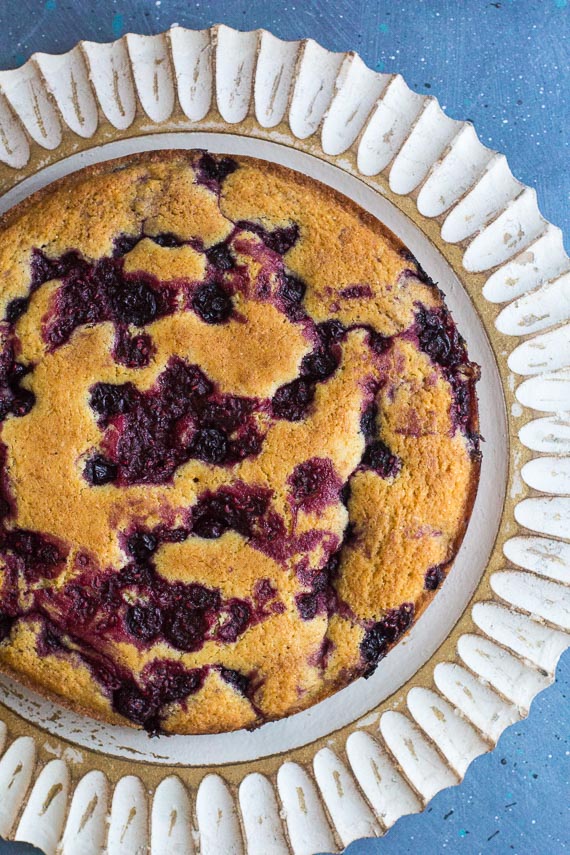
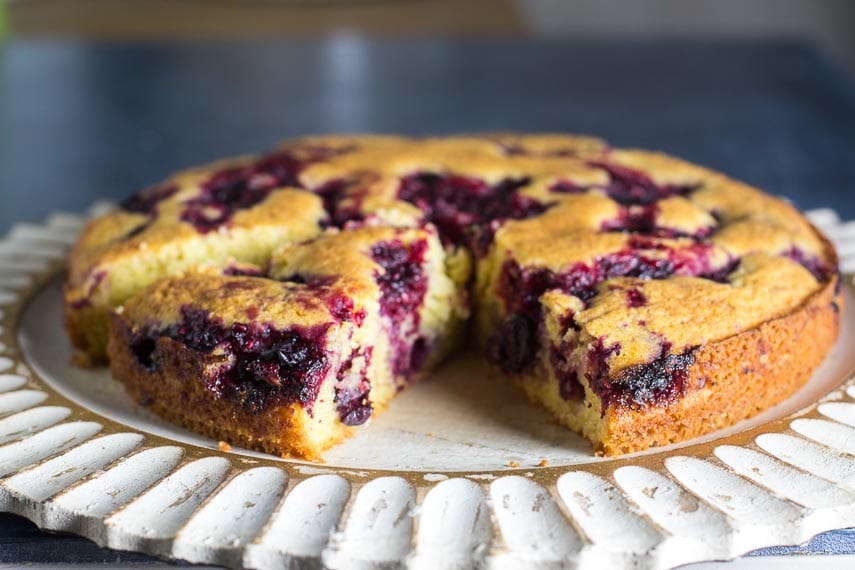
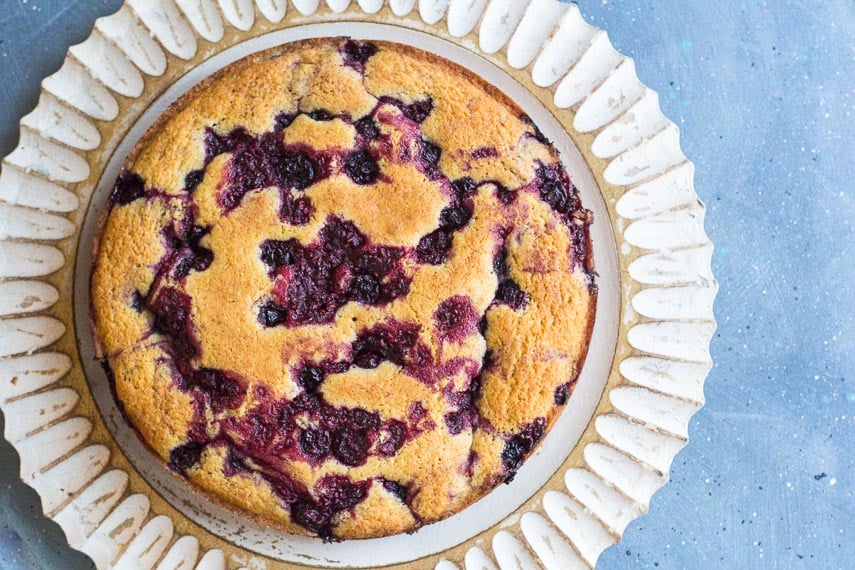
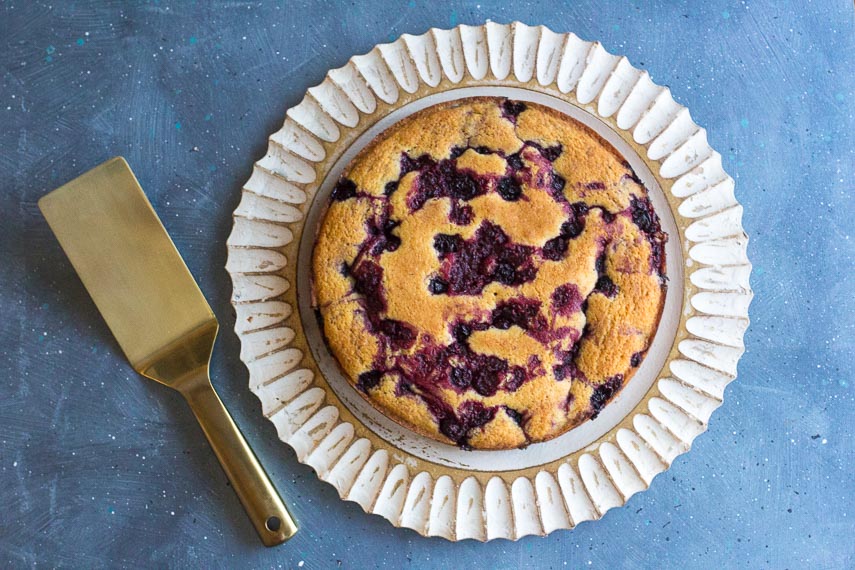
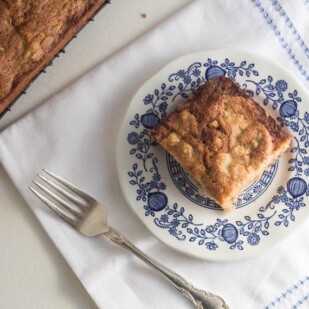





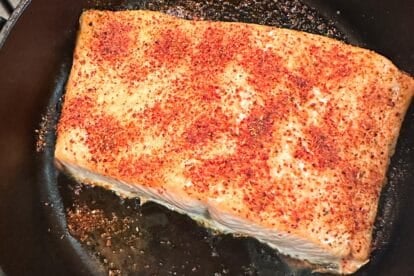

Excellent cake. Moist and light and I like that it is not too sweet. I only had 2% no lactose milk, and it worked well. And both my blueberries and raspberries were frozen – so i was worried they would be too liquidy, but they worked just fine.
Great report that will help others. Thank you for letting us know and that you enjoyed it. I love it with tea in the morning or as a snack.
So yummy! I don’t have a springform pan so I baked it in my Pyrex pie plate and it turned out great! Looking forward to having it for breakfast with my coffee tomorrow.
Great to know! Thank you for letting us community know they can approach it a different way. Thank you for writing:)
My husband and I both agree that this cake is a winner! I used frozen berries, it was cooked in 25 minutes, was lovely and brown on top and lovely and moist inside. Great with a dollop of yoghurt or cream on top😁
My kind of snack and treat! So glad you loved it.